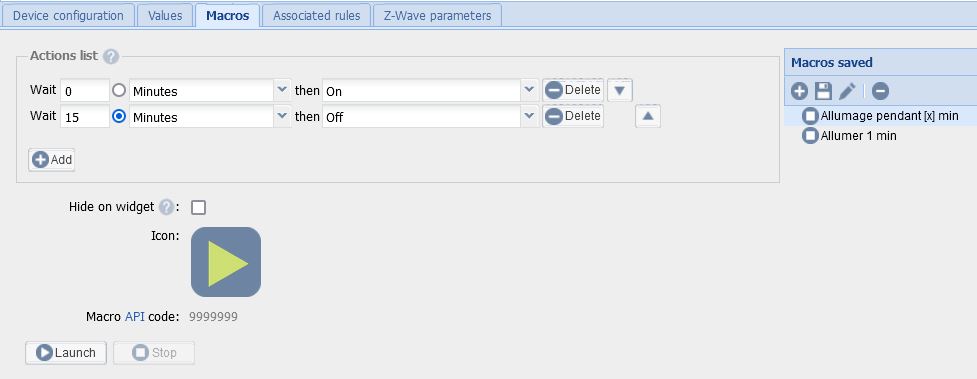Macros
From eedomus - Documentation
Macros
The eedomus macros correspond to a succession of actions to perform on a device.
Macros are only available for actuators and the tab will be grayed out or univisible for sensors.
- Timed waiting phase
Each macro element consists of a waiting phase and an action to perform.
The waiting phase can be zero (0 seconds/minutes/hours) in which case the action will be executed immediately when the macro element is triggered.
- Random wait phase
The use of the mode Minutes max. (random) allows to use random waiting times (convenient for the simulation of presence)
For example, when the following line of macros will be executed:
5 Minutes max (random) then On
The box will wait between 0 seconds and 5 minutes before executing the action On.
For example, the first time a macro is launched, it can wait 30 seconds before turning on the lamp, then 4 minutes the next time, then 2 minutes, ...
Macros with variable duration
It is now possible to change the duration of a macro just before its execution with the macros with variable duration.
This macros are simple (just ON then a variable duration before the OFF).
Timer macros
Macros can be used to launch actions with different timings.
A rule or schedule can then run multiple macros on multiple devices at the same time. The macros will stagger the executions (with executions in 30 seconds, 1 minute, 2 minutes for example).
It is advisable to use sufficiently long durations (10 sec at least), to avoid entanglements of actions.
Additions
Some additional information:
- Only one macro can be run at a time on an actuator
- Do not use for critical systems: there is no guarantee that in reality, the actions will always have the same temporal order and especially the same duration.
- The time of the actions is recorded when the macro is launched by the eedomus box. If a radio actuator is not available, the next action may overwrite the previous one if the latter is still not executed.
- The macro is interrupted if an action is launched manually from an interface or if the device sends a new value (which generally corresponds to a manual change on the device)
- If an action to an actuator is launched by the rule engine, it does not interrupt the current macro (unlike an action launched manually by an interface)





